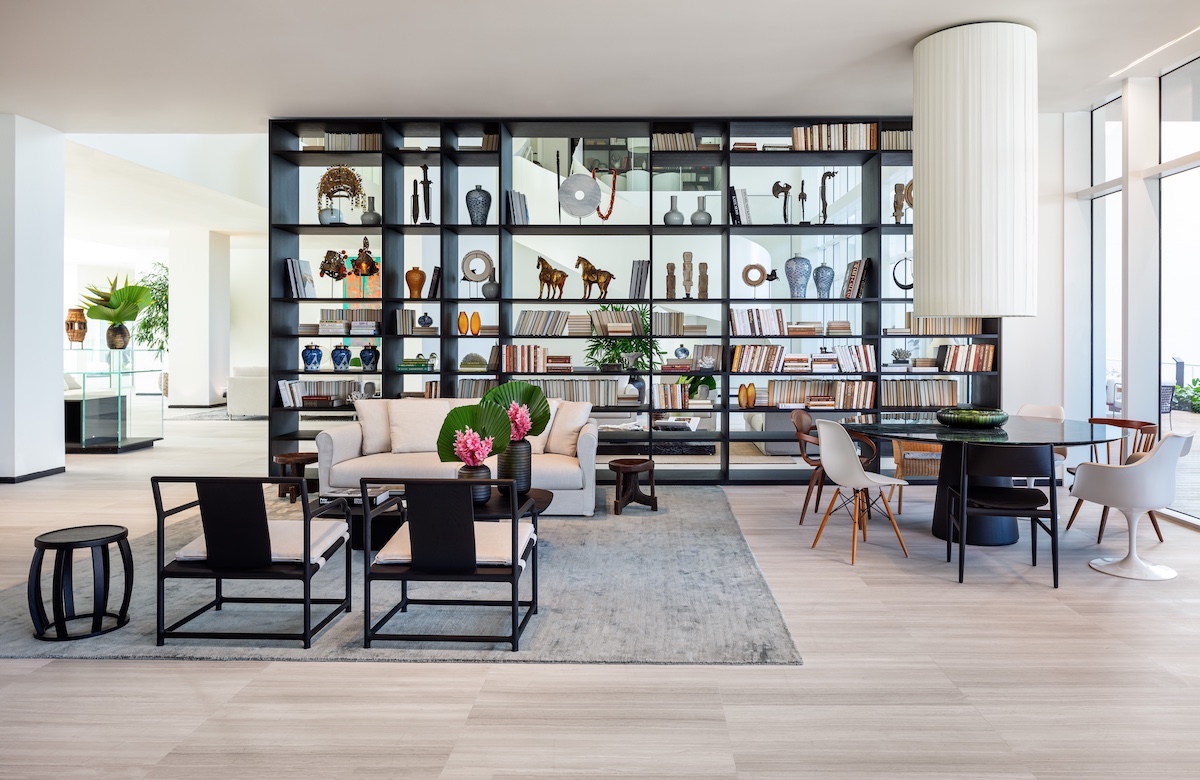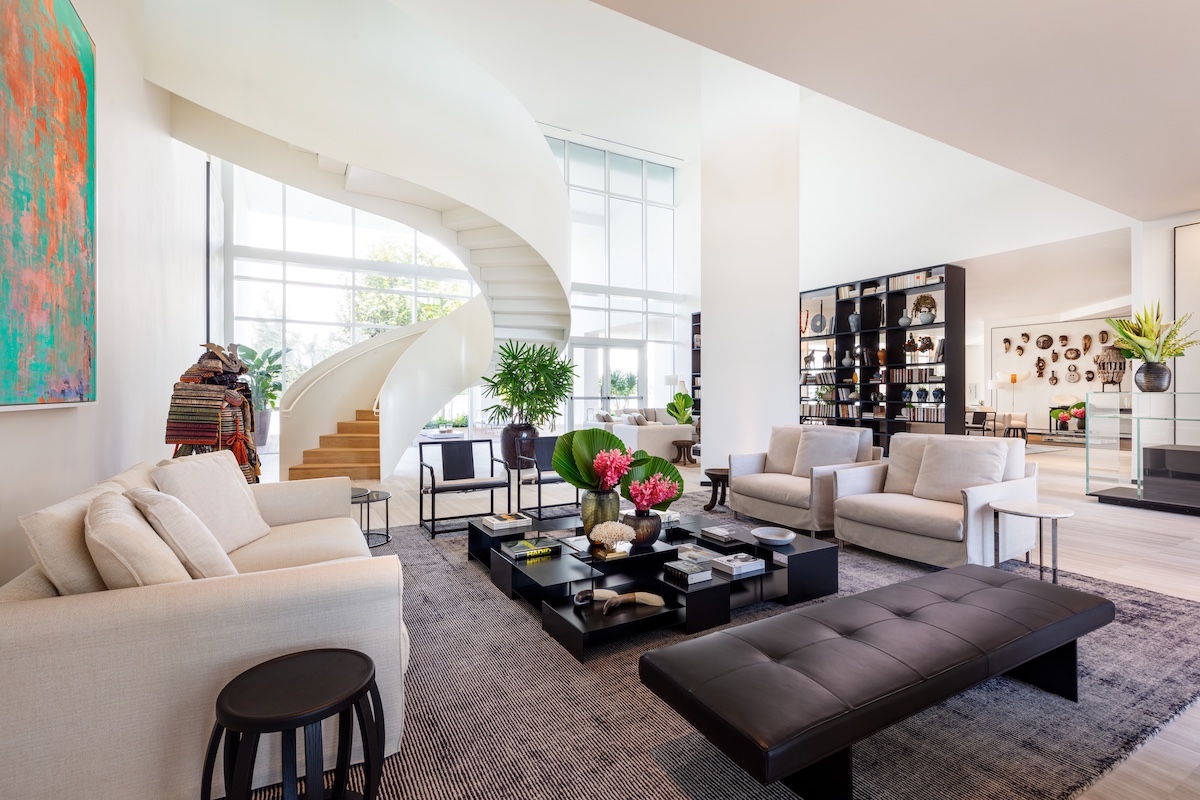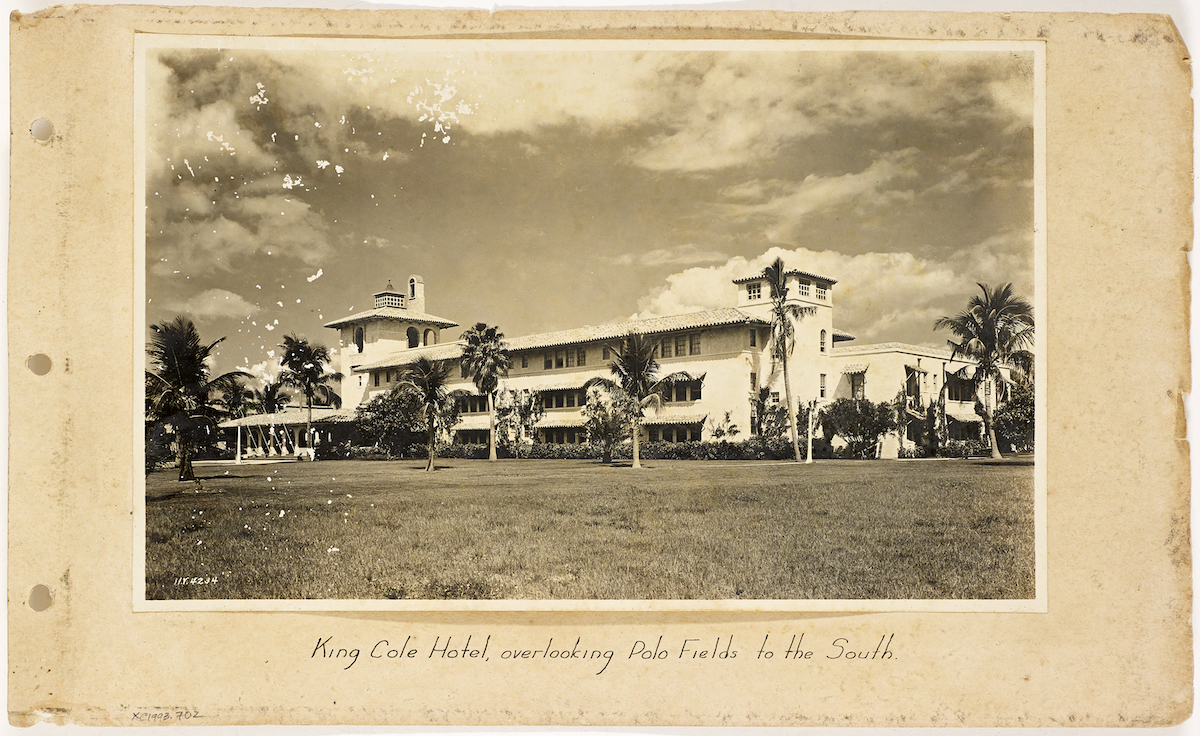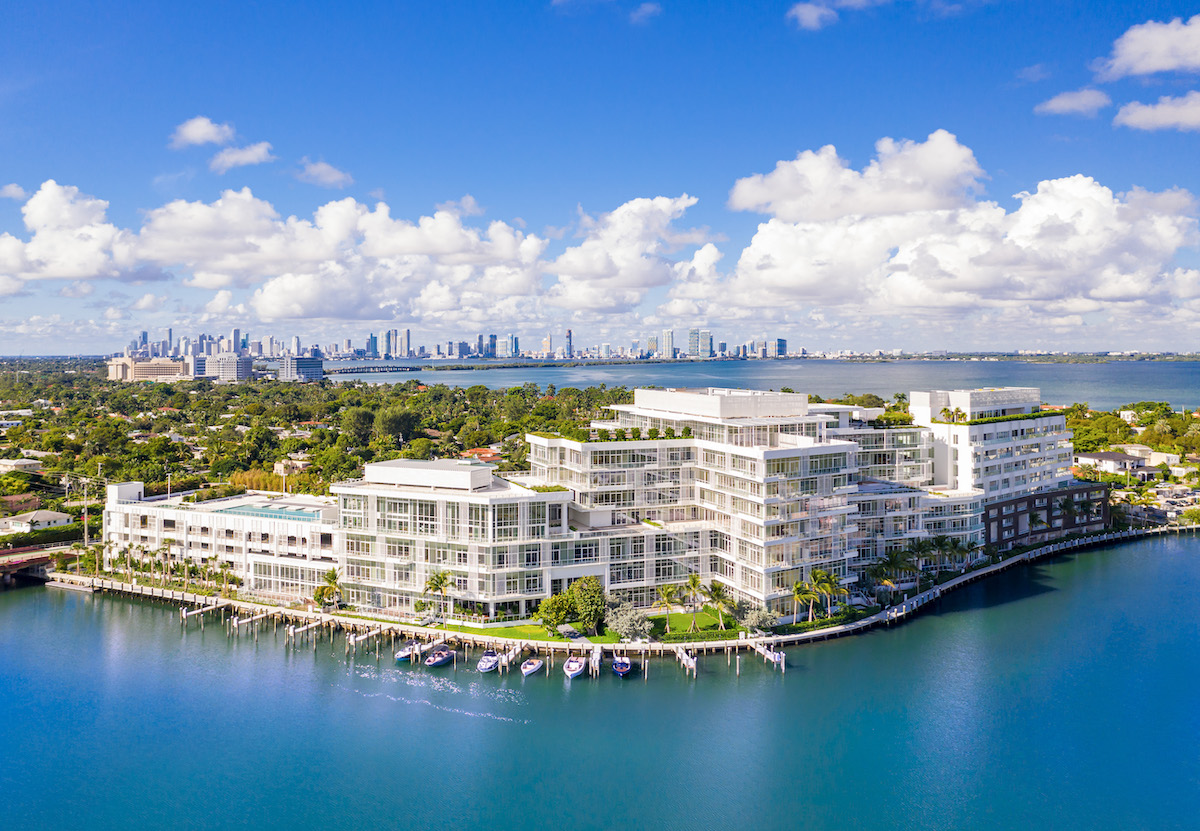In the 1920s, the King Cole Hotel helped put Miami Beach on the map as a popular tourist destination. Automotive industry pioneer and entrepreneur Carl Fisher developed the three-story, 60-room hotel to fulfill his vision of turning vacant land into an oceanfront winter getaway.
The hotel, which functioned as a military hospital during World War II, faced the wrecking ball in 1965 to make way for the property’s next occupant: the Miami Heart Institute. Over the next three decades, the hospital expanded its footprint on the 7.2-acre site to encompass six structures.
In 2000, Mount Sinai Medical Center acquired the Miami Heart Institute and ultimately consolidated its operations at the competing hospital system’s main campus about a mile away.
Real estate investment and development firm Lionheart Capital stepped in to purchase the deserted complex for $20 million in 2012, initiating the property’s third act as a luxury condo development. “It was a fair price, in an excellent location, and we felt confident we could transform the property into something truly special,” said Allison Greenfield, Partner at Lionheart Capital.

Residents have 24-hour access to a private art studio equipped with easels, sculpting surfaces, reference books, and supplies. Photo: Kim Sargent
But Lionheart faced some tough obstacles in converting the former hospital into condos—and starting from scratch wasn’t an option. “The site was overbuilt by about 600,000 square feet, so we would lose that space if we demolished the buildings,” said Greenfield. Rezoning the property to residential use would also limit the maximum building height of new construction to four stories.
Lionheart enlisted Stantec’s Miami practice to oversee the conversion process as architect of record. “The city was eager to approve the zoning change as long as the neighbors were in favor of it,” said Christina Villa, Senior Associate in Stantec’s Miami office.
ALSO SEE: Historic ‘skyscraper hospital’ in Brooklyn refashioned into 17 luxury condominium residences
Stantec staff met with residents of the surrounding Mid-Beach neighborhood, composed of single-family homes that range from historic 1920s structures to modern residences. “Most of the neighbors were ecstatic to hear that we were planning a condo development because it would decrease traffic and be more compatible with the neighborhood,” said Villa.
The intricate planning and design process involved reconfiguring the existing institutional building layouts to accommodate high-end residential units. “We stripped away everything that made the complex look like a hospital and brought it down to its bare columns, then started to carve out the massing of the buildings to make the floor plates work,” said Villa.
The process yielded a staggering 64 different unit layouts. “Unlike a typical South Florida multifamily building, where buyers choose a view and a stock layout, we essentially created 64 vertically stacked single-family homes,” said Greenfield.

The club room at the Ritz-Carlton Residences. Residents have access to the services of the Agatston Center for Private Medicine, led by Arthur Agatston, the cardiologist who created the South Beach Diet. Photo: Kim Sargent
Because the slabs between adjoining buildings did not align, the Stantec team planned each unit within the floor plates of its original structure, then created several new elevator lobbies that would transport residents directly up to their units.
The lower levels of the former hospital featured floor-to-floor heights of 12 to 14 feet, providing opportunities to create one-of-a-kind living spaces. “The price point for those lower floors is much higher than you would typically find in a condo tower because the units are so spectacular,” said Greenfield.
Miami's Ritz-Carlton Residences feature EUROPEAN ELEGANCE, MODERNIST AESTHETIC
To achieve its goals of establishing a European modernist design aesthetic, Lionheart engaged Italian architect and industrial designer Piero Lissoni as design architect. It was the first large-scale building project in the U.S. for the founder of Lissoni & Partners, an architecture and design studio with offices in Milan and New York.
Likening the property to “a new, small Portofino town,” Lissoni focused his attention on the building forms, façades, and public spaces. He also collaborated with Italian product designer Boffi to custom design the European-style kitchens and bathrooms in each unit.
When visitors enter the double-height main lobby, they have no clue they’re stepping into an environment that formerly housed an emergency department and surgical suites. Instead, they’re likely to be awed by the ironclad floating spiral staircase that anchors the space and the floor-to-ceiling glass wall that accentuates views of the adjacent private lake.

A floating spiral staircase marks the double-height main lobby, designed by architect Piero Lissoni, whose goal was to create the effect of a small fishing village in his native Italy. Photo: Kim Sargent
GUEST SUITES ADD A NEW OPTION TO THE MIX
The 678,000-sf Ritz-Carlton Residences, Miami Beach houses 111 condos that range in size from 2,000 sf to more than 10,000 sf and are priced from $2 million to $40 million. Also available for purchase are nine guest suites that function like hotel rooms and are positioned around an outdoor meditation garden. With the onset of COVID-19 lockdowns and work-from-home mandates, a few residents opted to convert these suites into private office environments.
Other outdoor amenity areas include a walking track that circumnavigates the property and a half-acre rooftop pool deck with private cabanas. Located atop the former hospital’s main parking structure, the expansive space offers panoramic vistas of the Atlantic Ocean, Biscayne Bay, and downtown Miami.
ALSO SEE: Designing multifamily housing for COVID-19
Residents can grow and pick their own fruits, vegetables, and herbs in the ecological food forest and community garden. They can even take advantage of a medical concierge service offered by the Agatston Center for Private Medicine, led by cardiologist Arthur Agatston, creator of the South Beach Diet.
A 36-slip private marina and captained day yacht on the neighboring Surprise Lake further distinguish the property from the region’s many other condo developments. Phase two, currently under construction, will add 15 single-family custom villas.
Since opening in February, the development is nearly sold out and has attracted an uncharacteristically large number of Florida-based residents. “I think it appeals to local buyers who may be leaving their house, but still want to maintain the individuality and specialness of their home environment,” said Greenfield. “The site is located in a beautiful, bucolic neighborhood that is perfect for those who really enjoy the South Florida lifestyle, and not just the weather.”

A postcard of the King Cole Hotel, built in 1920 by automotive industrialist Carl Fisher. The hotel was later converted to a hospital before being transitioned into residential use. Photo courtesy Stantec
PROJECT TEAM | THE RITZ-CARLTON RESIDENCES, MIAMI
DEVELOPER Lionheart Capital
DESIGN ARCHITECT | INTERIOR DESIGNER Lissoni & Partners
ARCHITECT OF RECORD Stantec
STRUCTURAL ENGINEER McNamara Salvia
CIVIL ENGINEER Kimley Horn
MEP ENGINEER Steven Feller, PE
BUILDING ENVELOPE CONSULTANT Paramount Consulting and Engineering
LANDSCAPE ARCHITECT Rhett Roy Landscape Architecture Planning
GENERAL CONTRACTOR Plaza Construction
Related Stories
| Mar 17, 2011
Perkins Eastman launches The Green House prototype design package
Design and architecture firm Perkins Eastman is pleased to join The Green House project and NCB Capital Impact in announcing the launch of The Green House Prototype Design Package. The Prototype will help providers develop small home senior living communities with greater efficiency and cost savings—all to the standards of care developed by The Green House project.
| Mar 11, 2011
Renovation energizes retirement community in Massachusetts
The 12-year-old Edgewood Retirement Community in Andover, Mass., underwent a major 40,000-sf expansion and renovation that added 60 patient care beds in the long-term care unit, a new 17,000-sf, 40-bed cognitive impairment unit, and an 80-seat informal dining bistro.
| Mar 11, 2011
Mixed-income retirement community in Maryland based on holistic care
The Green House Residences at Stadium Place in Waverly, Md., is a five-story, 40,600-sf, mixed-income retirement community based on a holistic continuum of care concept developed by Dr. Bill Thomas. Each of the four residential floors houses a self-contained home for 12 residents that includes 12 bedrooms/baths organized around a common living/social area called the “hearth,” which includes a kitchen, living room with fireplace, and dining area.
| Mar 11, 2011
Texas A&M mixed-use community will focus on green living
HOK, Realty Appreciation, and Texas A&M University are working on the Urban Living Laboratory, a 1.2-million-sf mixed-use project owned by the university. The five-phase, live-work-play project will include offices, retail, multifamily apartments, and two hotels.
| Mar 1, 2011
How to make rentals more attractive as the American dream evolves, adapts
Roger K. Lewis, architect and professor emeritus of architecture at the University of Maryland, writes in the Washington Post about the rising market demand for rental housing and how Building Teams can make these properties a desirable choice for consumer, not just an economically prudent and necessary one.
| Feb 15, 2011
New Orleans' rebuilt public housing architecture gets mixed reviews
The architecture of New Orleans’ new public housing is awash with optimism about how urban-design will improve residents' lives—but the changes are based on the idealism of an earlier era that’s being erased and revised.
| Feb 11, 2011
Chicago high-rise mixes condos with classrooms for Art Institute students
The Legacy at Millennium Park is a 72-story, mixed-use complex that rises high above Chicago’s Michigan Avenue. The glass tower, designed by Solomon Cordwell Buenz, is mostly residential, but also includes 41,000 sf of classroom space for the School of the Art Institute of Chicago and another 7,400 sf of retail space. The building’s 355 one-, two-, three-, and four-bedroom condominiums range from 875 sf to 9,300 sf, and there are seven levels of parking. Sky patios on the 15th, 42nd, and 60th floors give owners outdoor access and views of Lake Michigan.
| Feb 11, 2011
Sustainable community center to serve Angelinos in need
Harbor Interfaith Services, a nonprofit serving the homeless and working poor in the Harbor Area and South Bay communities of Los Angeles, engaged Withee Malcolm Architects to design a new 15,000-sf family resource center. The architects, who are working pro bono for the initial phase, created a family-centered design that consolidates all programs into a single building. The new three-story space will house a resource center, food pantry, nursery and pre-school, and administrative offices, plus indoor and outdoor play spaces and underground parking. The building’s scale and setbacks will help it blend with its residential neighbors, while its low-flow fixtures, low-VOC and recycled materials, and energy-efficient mechanical equipment and appliances will help it earn LEED certification.
| Feb 11, 2011
Apartment complex caters to University of Minnesota students
Twin Cities firm Elness Swenson Graham Architects designed the new Stadium Village Flats, in the University of Minnesota’s East Bank Campus, with students in mind. The $30 million, six-story residential/retail complex will include 120 furnished apartments with fitness rooms and lounges on each floor. More than 5,000 sf of first-floor retail space and two levels of below-ground parking will complete the complex. Opus AE Group Inc., based in Minneapolis, will provide structural engineering services.
| Jan 27, 2011
Perkins Eastman's report on senior housing signals a changing market
Top international design and architecture firm Perkins Eastman is pleased to announce that the Perkins Eastman Research Collaborative recently completed the “Design for Aging Review 10 Insights and Innovations: The State of Senior Housing” study for the American Institute of Architects (AIA). The results of the comprehensive study reflect the changing demands and emerging concepts that are re-shaping today’s senior living industry.














